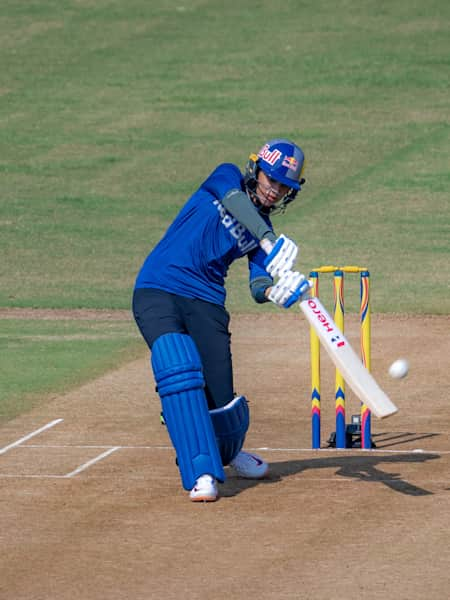
Smriti Mandhana is one of the most elegant batters in the world.
The southpaw is known for striking the ball with incredible timing and making every shot look good.
But what a lot of people don’t know is that Smriti is naturally right-handed but trained to bat as a left-hander when she was young. She would watch her elder brother practice – he was a left-handed batter – and wanting to emulate his style, so she switched her batting stance from right to left-handed.
She has grown into that role to become one of the best batters in the world. She became the third Indian woman to score 1000 T20I runs in 2018 and became the third-fastest female cricketer in the world to score 2,000 ODI runs in 2019.
It is widely known that left-handed batters enjoy several advantages that right-handers don’t. And many cricketers have opted to switch stance to make the most of those advantages.
“I think there are a lot of advantages of being a left-handed batter because not every team has a lot of left-handers, so the bowlers are mostly used to bowling to right-handers. Of course they do practice bowling to left-handers but [not as much] and we (left-handers) get a lot of loose balls. We get a few balls going down the leg and we get balls in our hitting area more often than the right-handers,” Smriti explains.
However, being a great left-handed batter does not come without practice.
Here are Smriti’s expert tips on how to become a better left-handed batter.
01
Tip 1: Maintain a balanced stance
Since bowlers will usually change to bowl over the wicket to a left-hander, their deliveries may not always land on leg or middle stump. Smriti’s advice is to not let your head fall to the offside too much.
“I think as a left-hander your stance is very important because most of the times the bowlers bowl from over the wicket to you and to right-handers they bowl from wide off the crease. So as a left-hand batter you have to have a very balanced stance and you cannot let your head fall over on the offside because they will keep bowling to you from over and not mostly on your legs and middle stump,” explains Smriti.
02
Tip 2: Try to play as long an innings as possible
In particular, if you are partnering with a right handed batter, try to extend your innings as long as possible. Bowlers need to keep changing their approach to a left-right partnership. And field placements also need to keep changing. This will tire out the bowlers and fielders, so chances for more errors which you could exploit.
“Left-hand batters are an asset to any team because if they go on to play all the overs in a game, it can be very tough on the fielders and bowlers as they will have to keep changing their bowling lines and lengths, and the field placements. So I think it is really important for the left-handers to play long,” says Smriti.
03
Tip 3: Timing the ball is a left-hander’s biggest asset
As opposed to powerhitting and other techniques, left-handers are able to exploit natural errors much better by playing a simple game.
“I think most of the lefties are timing-based batters so they should just focus on the timing,” she advises.
04
Tip 4: Practice more for off-spinners, particularly for limited overs
Off-spinners pose a greater threat to left-hand batters since the ball spins away and there's always a chance of an outside edge. It is thus important for southpaws to spend sufficient time practising against off-spinners.
“Left handers have slight problems with off spinners. I used to have a lot when I was growing up. But I think practising against more off-spinners helps you know which ball to step out for and which ball to play from deep inside the crease,” says Smriti.
However, she says that limited overs cricket tends to have flatter tracks and smaller boundaries, making it easier for lefties to play off-spin.
“With the kind of wickets we are getting in white ball cricket these days, it is not that tough to bat an off spinner. You have to be aggressive in your mind,” she adds.
05
Tip 5: Pay attention to the rough of the pitch
You often see certain parts of the pitch getting rough because of bowler run-ups. Spin bowlers will often try to pitch in this area since it can produce more turn; this becomes especially difficult for left-handers facing off-spin. Smriti suggests two tips for this situation.
“Rough patch is made by the pace bowlers. Sometimes when the wicket is too dry in the ODIs, left-hand batters have to be slightly more careful against the spinners. There are two tips for this – (1) step out and reach the pitch of the ball or (2) go extremely inside the crease and try to play after the ball spins. You can try this if the ball is turning a lot from the rough areas,” she elucidates.
06
Tip 6: Practice drills alongside right-handed batters
There aren’t any dedicated batting drills for left-handers that are different from right-handers. So it is possible to learn from each other in the same drill sessions.
“I don't think there are any specific drills for lefties. Each player has their strengths and weaknesses, and everyone should practice drills accordingly. Drills are the same for both right-handers and left-handers,” Smriti says.
07
Tip 7: Check for equipment specially designed for left-handers
Certain batting equipment is specially designed for left-handed batters. For example, batting gloves made for lefties have extra padding on the left thumb.
“The gloves and thigh pads are different for left-handers than they are for right-handers,” Smriti confirms. While not the most important point, it does help to have the correct equipment.











